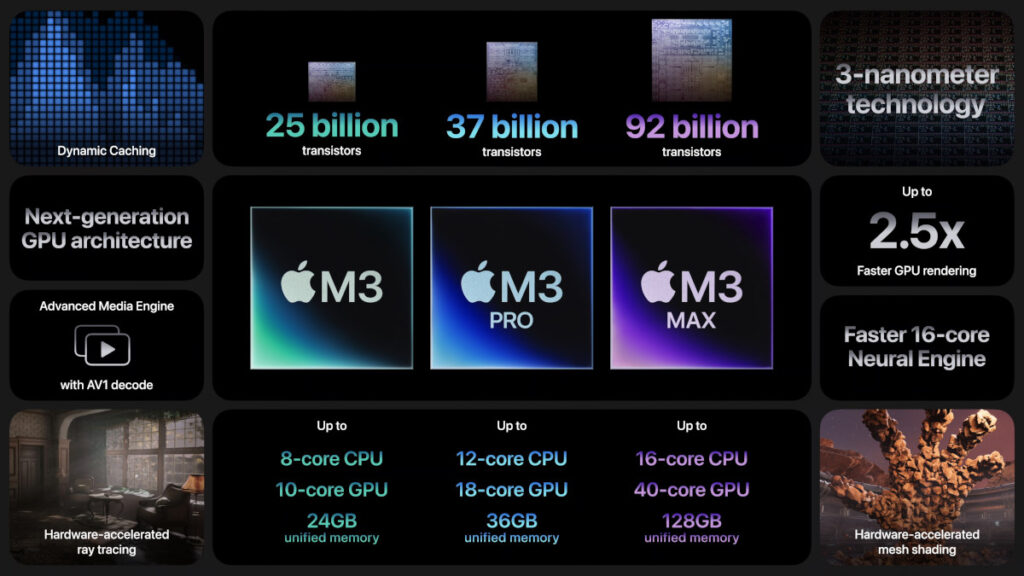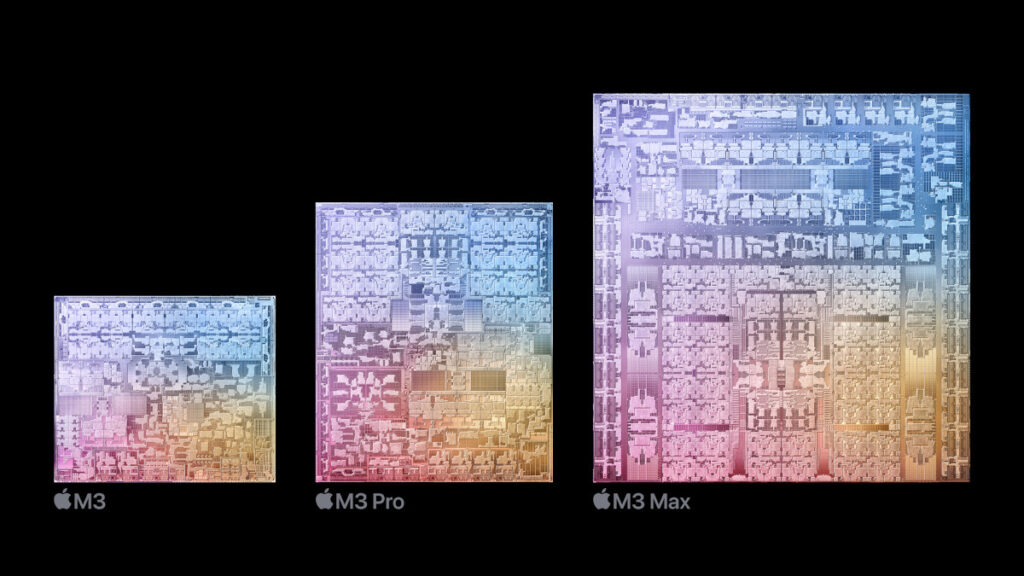Apple MacBook Pro M3 Pro & M3 Max
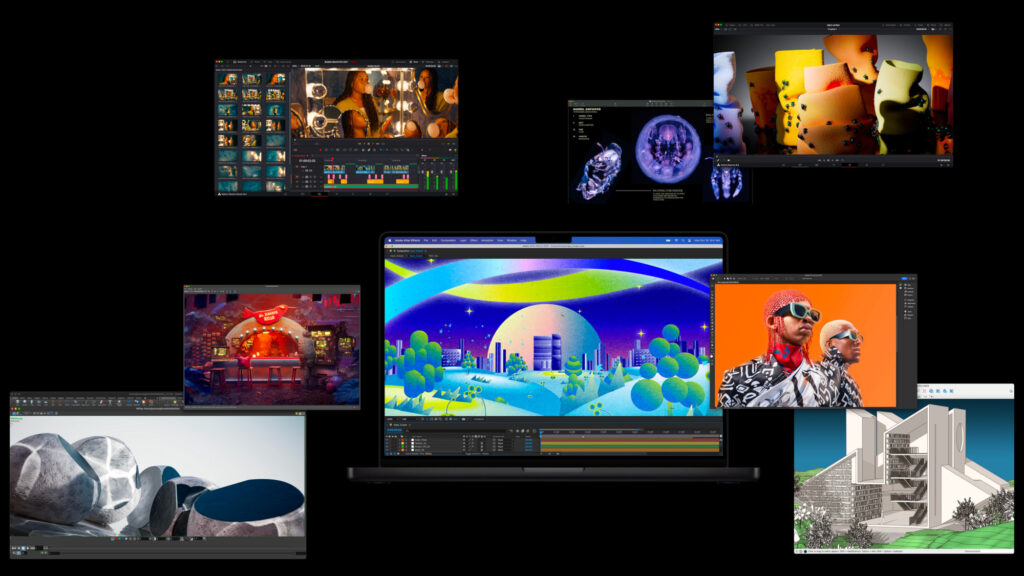
The Apple MacBook Pro M3 Pro & M3 Max are Apple’s best 2023 Q4 laptops and the ultimate laptops for musicians/creators
Apple 16″ MacBook Pro M3 Pro $2499.00 – M3 Max $3499.00 minimum per processor type
Apple 14″ MacBook Pro M3 Pro $1999.00 – M3 Max $3199.00 minimum per processor type
If you’re a serious pro or amateur musician, you really want the Apple Mac Studio M2 Max & M2 Ultra or the Apple MacBook Pro M3 Pro & M3 Max. A large music and/or video recording studio without budget restraints or someone who must have PCIe slot expansion may want to consider the Apple Mac Pro M2 Ultra. These are the three best computers for creatives you can buy today.
If you absolutely must spend less than $1999.00, consider buying used, refurbished or consumer level Macs like the Macbook Air, iMac or Mac mini. To suggest buying less than an Apple M Series system is bad advice. Also see notes below in the Unified Memory section.
See: Apple Silicon is the DAW standard.
The MacBook Pro M3 Series are the most powerful 2023 Q4 Apple laptops you can get and elegantly suited for creatives
Kudos to Apple for ditching the 13″ MacBook Pro with touch bar, and replacing it with an M3 version of the 14″ MacBook Pro. However, I’m not going to cover it on this page or recommend it.
I really don’t think it’s a good deal. No musician/creator should buy a system with 8GB memory, and when you upgrade it to 18GB, you might as well have an M3 Pro with an extra fan and Thunderbolt port. A lot of Apple apologists try to rationalize Apple’s 8GB entry level choices, but putting 8GB in any $1000+ non-upgradeble machine in 2020+ is just plain bogus. Enough said.
The MacBook Pro M3 Pro & M3 Max laptops are very similar to the MacBook Pro M2 Pro & M2 Max versions except for the new processors with different CPU/GPU core counts and unified memory limits. There is also the new Space Black color and for the first time, the 14″ MacBook Pro M3 Max has a high power mode that maximizes performance in intensive sustained workloads, just like the 16″ M1/M2/M3 Max MacBook Pros do.
Various builds have 11-16 CPU cores, 10-40 GPU cores, 16 Neural Engine cores, 8GB-128GB RAM, media engine enhancements, memory bandwidth of 150GB/sec to 400GB/sec, 3 Thunderbolt 4 (USB-C) ports, HDMI, internal display 3024×1964/3456×2234, external display to 8k.
Apple has re-balanced the M3 Pro and M3 Max with a larger performance gap between them. The M3 Pro is a clear performance improvement over the M2 Pro, but has more emphasis on power efficiency than performance improvement, which is probably a good thing. The M2 Pro already screams and power efficiency is always a good thing in a laptop. Don’t be mislead by YouTube influencers, in some ways the M3 Pro is a technical specification side-grade from the M2 Pro but the M3 Pro is clearly a performance and efficiency improvement.
I bought two of the 14″ 12‑core CPU, 18‑core GPU M3 Pros for the Turtle Island moderators which I thought were well worth the $200 CPU/GPU and the $400 36GB upticks. However, I would have still bought the 11‑core CPU, 14‑core GPU, 18GB M3 Pros if that were the only option or we were financially constrained.
For an easy to view chart of processor differences, see: Apple M3 Processor Series.
The MacBook Pro M3 Pro and M3 Max are the best laptops to date Apple has produced, and will remain so until the M4 Pro and M4 Max versions are released. If you want a laptop for creative pursuits, the MacBook M3 Pro and M3 Max are the best money can buy. Apple has continued to improve these machines. The design and performance of these machines builds on exquisite.
There are many ways to configure these laptops and everyone’s needs are different. First you need to decide if you want a 14″ or 16″ form factor.
The 16″ MacBook Pro is more of a hybrid laptop/desktop
If you prioritize larger screen size, minor sustained heavy load performance/thermal gains, and/or peak battery life over portability, the 16″ may be for you. Generally, I would characterize the 16″ as more of a hybrid laptop/desktop. It is a bit much for lugging around with you on the go. If you don’t move it a lot though, the screen is very attractive and the form factor/cooling is most appropriate for M3 Max sustained heavy load performance.
Keep in mind though, that realistically for a performing musician, any laptop DAW’s size/weight are going to be nothing next to guitars, synthesizers, amplifiers, and other gear, and the 16″ screen would be a lot easier to see on stage. But if you are on the move a lot, back and forth from work, customers, clients, coffee shops, or whatever, the 14″ may be more for you.
The 14″ MacBook Pro fits my portability needs
In January 2023, I purchased a 14″ MacBook Pro M2 Pro, with 12 core CPU, 19 core GPU, 16GB of memory and 1TB storage. At that time, I decided then that for my portability needs, it didn’t make sense to bump the memory or processor/GPU cores up. As a secondary system, I found the M2 Pro with 16GB to be very adequate for my needs, but as I expanded uses of the laptop, I yearned for more memory. For reference sake, note that I have a Mac Studio M1 Ultra for my primary system.
In January of 2024, one of my granddaughters needed a laptop for college and I was able to rationalize an upgrade. I gifted her the M2 Pro and upgraded to a 14″ MacBook Pro M3 Max, with 14 core CPU, 30 core GPU, 36GB of memory and 1TB storage.
I regularly use most of the 64GB on my primary system. If this M3 Max were my primary system, it would have been tempting to go with 96GB. I never would have guessed it a few years ago, but I am really getting used to having large amounts of memory.
Most of my workstation needs are met by my desktop Mac Studio M1 Ultra, but this MacBook Pro compliments it well. In Geekbench, the M3 Max 14 core CPU, 30 core GPU is faster in single and multi core CPU benchmarks and slower in GPU benchmarks than my M1 Ultra 20 core CPU, 48 core GPU. From my perception, both machines seem about the same which is totally wild to me.
The 14″/16″ MacBook Pros are almost exactly the same
Other than system/screen size/weight, minor sustained heavy load performance/thermal differences, minor peak battery life differences and very minimal speaker quality differences, the 14″ and 16″ MacBook Pros are exactly the same.
The M3 Pro has 150GB/s memory bandwidth and the M3 Max 14 CPU core has 300GB/s memory bandwidth. Both are (misleading) 25% specification downgrades from 200GB/s M2 Pro and 400GB/s M2 Max specifications that I wouldn’t concern yourself with. The M3 Max 16 CPU core has 400GB/s memory bandwidth. The M3 Pro/Max efficiency cores clock at 2.75 GHz and the performance cores at 4.05 GHz.
The M3 Pro has one video encoder, one video decoder, one ProRes encoder/decoder and either 18GB or 36GB memory. The M3 Max has two video encoders, one video decoder and two ProRes encoder/decoders. The M3 Max 14 CPU core can be configured with 36GB or 96GB of memory. The M3 Max 16 CPU core can be configured with 48GB, 64GB or 128GB of memory.
In my opinion the M3 Pro/M3 Max MacBooks are equal or improved in almost all ways to the M1 Pro/M1 Max and M2 Pro/M2 Max versions. The one exception is the 512GB SSD. It is not slow, but it is a single 512GB storage chip, rather than two chips and half the performance of a 1TB+ SSD in many cases.
Upgrading from an M1/M2 Pro or M1/M2 Max to the exact same model/configuration M3 Pro or M3 Max is probably not something many would do. M1/M2 Series computers still work great with plenty of power. There may not be enough to make the jump for, but the power gap is widening. If you need a different screen size, memory or storage, that could change the equation. If you have a Windows or Intel based Mac don’t hesitate to grab one of these. You will not regret it.
In the most basic uses, you would be hard pressed to tell the difference between M3 Pro/M3 Max MacBooks and the equivalent M1/M2 versions. And this is a good thing, the M1 Processor Series and the M2 Processor Series are great machines. Beyond basic uses though, the M3 Processor Series are noticeably and measurably better. In both CPU and GPU intensive applications, you will see gains, often significant, over the M1/M2 Series.
It is also worth stressing that the M3 Max outperforms or comes close to M1/M2 Ultra performance. In single and multi core CPU benchmarks, the 14/16 CPU core M3 Max is faster than the M1 Ultra, and darn close to the M2 Ultra. This is what matters with a DAW.
Unified Memory
One of the beautiful things about M series processors is the memory in the processor chip. The performance and efficiency results of this design are significant and unmistakable. Because of this design, you cannot upgrade the memory later. It is important to get a sufficient amount of memory.
Going backwards for a second, I stress getting any M Series with 8GB memory is a mistake for DAW users. People with simple needs do it, but they are not maximizing their performance potential. An M1/M2/M3 or M1 Pro/M2 Pro/M3 Pro with 16GB+ memory is the minimum to me. For many DAW users 16GB is too low as well. An M3 Pro with 18GB-36GB or M3 Max with 36GB will prove quite sufficient for most electronic or rock musicians.
However, if your projects include a lot of sampled instruments, orchestral arrangements or soundtrack work, you really should consider the 64GB, 96GB or 128GB M3 Max. I would venture very few will need more than 128GB, but if you do, you need a desktop Mac Studio M2 Ultra to go to 192GB. If you need that much memory, you probably already know it.
Desktop vs. Laptop
My bias or transparent needs: Prior to using the Mac Studio M1 Ultra, I had been computing with laptops only (except servers) for over a decade, but at this point in my retired life, I have very little need for major horsepower portability. For me a powerful desktop is more useful than a laptop. My recording studio doesn’t move and I don’t gig either. The Mac Studio makes much more sense for me than a MacBook Pro as a primary computing device. 10% of the time when I do need portable computing, I don’t need the super performance horses, or the weight/bulk of lugging around a 16″ laptop. A 14″ MacBook Pro/Max suits my backpack and travel needs best. I could easily live with nothing but any 16GB+ 14″ MacBook Pro M Series and a 27″ external monitor if I needed to though.
My needs or any opinionated influencer’s needs are meaningless for you though. Pick what you need. If you need or prefer a laptop, then that is the best choice. If you need or prefer a desktop, then that is the best choice. There is no such thing as one all around best computer.
Information you need to properly digest web sites & especially YouTube.
Updated frequently – Apple Technology YouTube Critique
CPU & GPU Performance Benchmarks
I would generally advise to not get too tied up in the minutiae of benchmarks, but they are useful for relative comparisons of processors. It is worth noting that no M Series processors are slouches. Some more than others, but all of them are a noticeable improvement over the Intel processors in previous generation Macs.
CPU single-core performance of all M3 Series processors are very similar, because of course they all share the same CPU single-core.
CPU and GPU multi-core performance is where the differences become more apparent because of the different number of cores.
SSD Performance Benchmarks
I can’t personally speak to all capacities, but the 1TB SSD is a blazing fast SSD as benchmarked by the Black Magic Disk Speed Test. WRITE and READ results are consistently over 5000 MB/s, often significantly so. This is my MacBook Pro M3 Max 1TB SSD. M3 Pro/Max SSDs are the same. 512GB could be half this, and 2TB+ capacities are equal or faster.
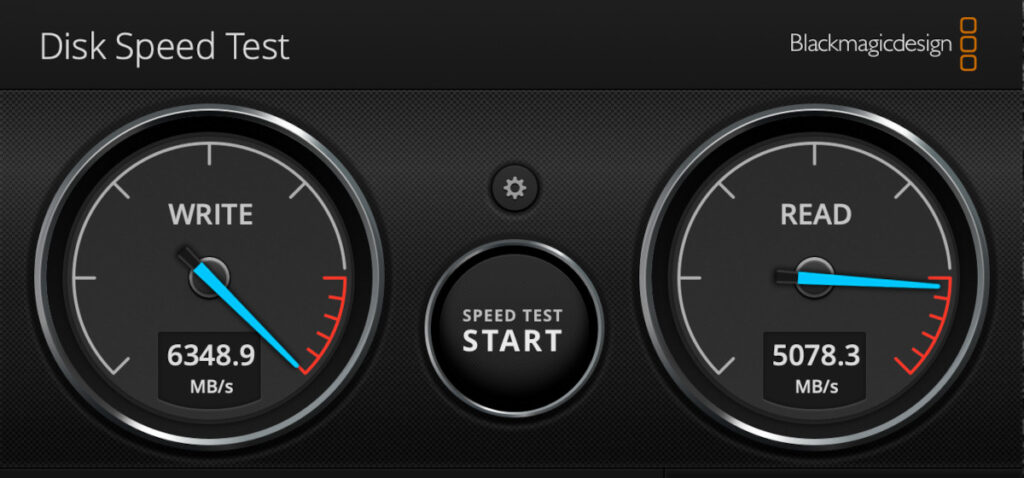
Battery
To me, M Series battery life is pretty much a non-issue. Capacities are similar (a lot!) and within a few hours of each other, though generally improved through the generations. More important than Apple estimates, you can turn on low power mode or turn down the screen brightness to increase your already great battery time if you need to. No other laptops have better or even equal battery life.
I recently went on a 5 day trip with my 14c M3 Max. With sporadic use every day and night, I did not have to charge the battery once though I did bring the charger. Back at home, I regularly go a couple days without a charge and I never bring the charger with me when I’m on the move.
DAW Performance Benchmarks
The M3 Pro/Max can handle at least similar tracks/load to the equivalent M1/M2 Pro/Max. MacBook Pros with the same processors will have roughly the same DAW performance in the 14″ or 16″ form factor.
Personally, I see the 14 CPU core, 30 GPU core M3 Max as the most bang for the buck sweet spot for a DAW, which is why I bought one.
There is no need to push your DAW to 1 track short of a crash. The maximum tracks I would load a MacBook up with would be 60%-70% of the maximum. No need to completely dog out the CPU, ha! These numbers would be comparable for Ableton Live or other DAWs as well.
FYI – DAWs are heavy on CPU use, with very little GPU load. Higher track count abilities are achieved by faster/more CPU cores and/or more memory. GPU cores will not benefit a DAW.
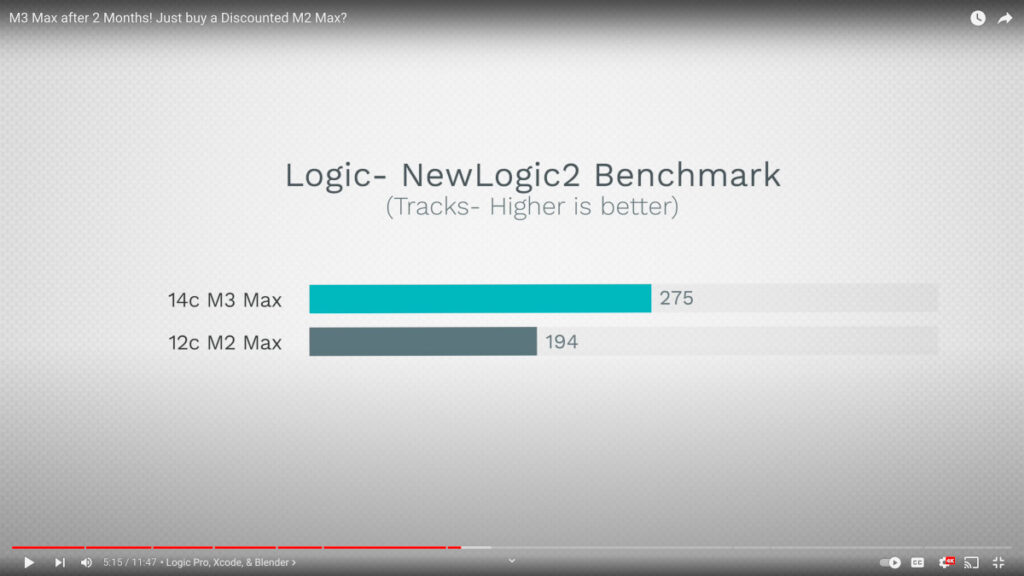
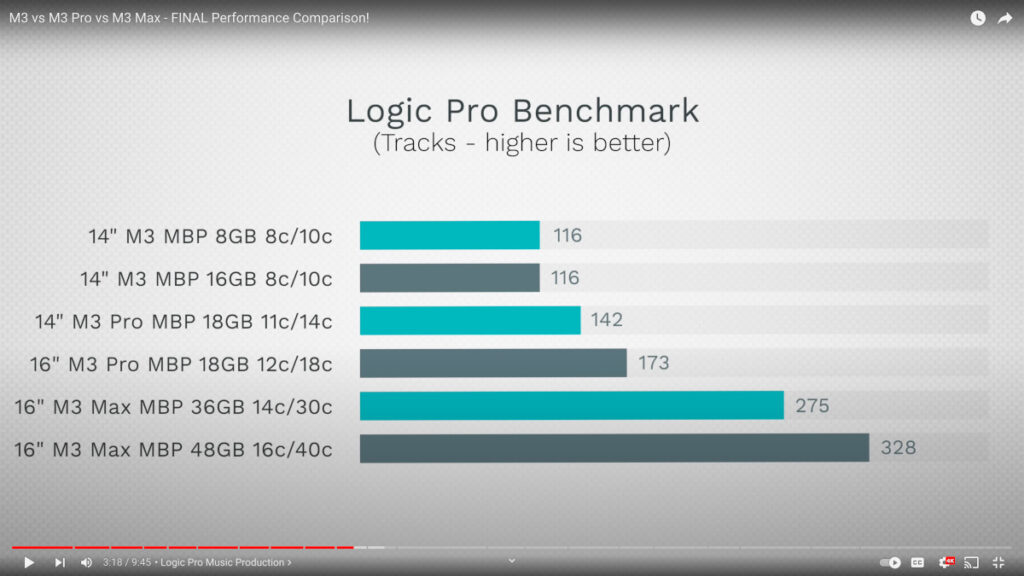
I would strongly recommend the M3 Pro/Max as the perfect processors for the majority of musicians. Your DAW is gonna hum like never before, and you will experience great video and graphics processing.
If you need the greatest possible CPU horsepower for a DAW, choose the 14 or 16 CPU core M3 Max or even a desktop M2/M3 Ultra. Extra GPU cores won’t help a DAW. Video and graphics processing are different issues of course.
Check software compatibilities
It should go without saying, but I’m gonna say it anyway. M Series has been out since November 2020. I think it’s crazy that any DAW or plugin should have issues or still be running on Rosetta emulation, but not everyone listens to me. Do your homework!
Furthermore, in my opinion any major software company that markets to Apple users and hasn’t updated their software to include Apple silicon compatibility deserves to lose your business. It’s been over 3 years, and at this point it’s a real screw you. They obviously don’t care about their customers and should be replaced by a company that cares more about their customers.
macOS 13 Ventura: Compatibility Guide
macOS 14 Sonoma: Compatibility Guide
My personal experience with Sonoma has been very good. Everything I use runs natively on M Series and is compatible with Sonoma. But don’t listen to me, do your homework!
Ports are important for musicians & content creators
The 3 Thunderbolt/USB-C ports on the MacBook Pro are likely adequate for most, and can also be easily expanded with a hub if you need more. Also an external monitor like the Apple Studio Display has 3 more USB-C ports in addition to the Thunderbolt 3 connection port. I would theorize that in portable mode you will not need more ports than are built in the MacBook, but in the studio you may.
You may want a USB-C to Ethernet RJ-45 adapter. You will want to plug your interface directly into USB-C or if you can’t do that, get a hub or adapter also for legacy USB-A hard drives, flash drives, cables to synths, cable to printer etc.
Obviously wise future purchases will be solidly Thunderbolt or USB-C. The HDMI will be very useful for TV, and occasionally most musicians like to plug headphones directly into the system, though most of the time it’s either through an interface or Bluetooth. You can also buy the Apple USB-C VGA Multiport Adapter for an older existing monitor if you need it. This adapter also has a USB-C and a USB-A.
MacBook hardware upgrades
Remember no internal hardware upgrades can be performed. This is especially true with Apple silicon. SoC or System on Chip as you probably already know, cannot be upgraded. The advantages are more than worth it, but push yourself to adequately configure memory and storage for the future.
External storage alternatives
I recommend backing up all data to the cloud, and supplementing the internal Apple SSD with an external USB-C or Thunderbolt SSD/HD.
SSD speed needs for music production are similar to photography and video. This video will help you choose external SSD solutions (also in YouTube playlist below).
See Apple M Series External USB-C SSD Options for a more extensive discussion and specific product recommendations.
The MacBook Pro M3 Pro & M3 Max have what it takes to get through the next 5+ years of your music & video productions
This is why you buy Apple. Realistically with the cost of computers these days, a 1-3 year refresh cycle is not practical for many people. Unlike the majority if not all PC systems, Apple computers are built to last and Apple silicon is state of the art enough to start you at the head of the pack.
Keep coming back
Thanks!
-Yehuda
Manufacturer’s website
https://www.apple.com/macbook-pro-14-and-16
Product support, downloads
https://support.apple.com
Videos
Yehuda Rothschild Apple MacBook Pro M3 Series YouTube Playlist
Yehuda Rothschild Apple Mac M Series Music Production YouTube Playlist
Useful Links
Apple related pages
Updated periodically – Apple Silicon is the DAW standard
Updated periodically – Apple Mac Studio M1 Max & M1 Ultra
Updated periodically – Apple Mac Studio M2 Max & M2 Ultra
Updated periodically – Apple Mac Studio M3 Max & M3 Ultra
Updated periodically – Apple Mac Studio M4 Max & M4 Ultra
Updated periodically – Apple MacBook Pro M1 Pro & M1 Max
Updated periodically – Apple MacBook Pro M2 Pro & M2 Max
Updated periodically – Apple MacBook Pro M3 Pro & M3 Max
Updated periodically – Apple MacBook Pro M4 Pro & M4 Max
Updated periodically – Apple Mac Pro M2 Ultra
Updated periodically – Apple Mac Pro M3 Ultra & M3 Extreme
Updated periodically – Apple Mac Pro M4 Ultra & M4 Extreme
Updated periodically – Apple Mac mini M1
Updated periodically – Apple Mac mini M2 & M2 Pro
Updated periodically – Apple Mac mini M3 & M3 Pro
Updated periodically – Apple Mac mini M4 & M4 Pro
Updated periodically – Apple Studio Display
Updated periodically – Apple M1 Processor Series
Updated periodically – Apple M2 Processor Series
Updated periodically – Apple M3 Processor Series
Updated periodically – Apple M4 Processor Series
Follow on Mastodon – TurtleIsland.social/@Yehuda
This page is subject to content updates/additions. If you think any content should be updated or added, please leave a private comment on Mastodon – TurtleIsland.social/@Yehuda.
